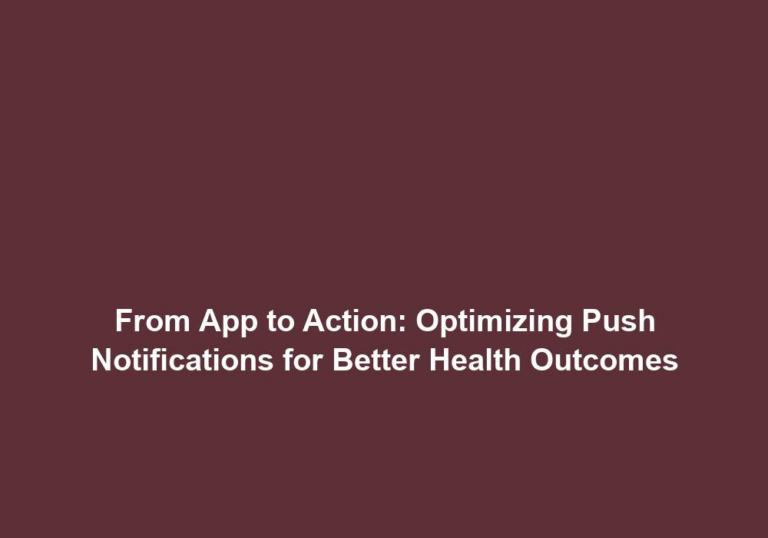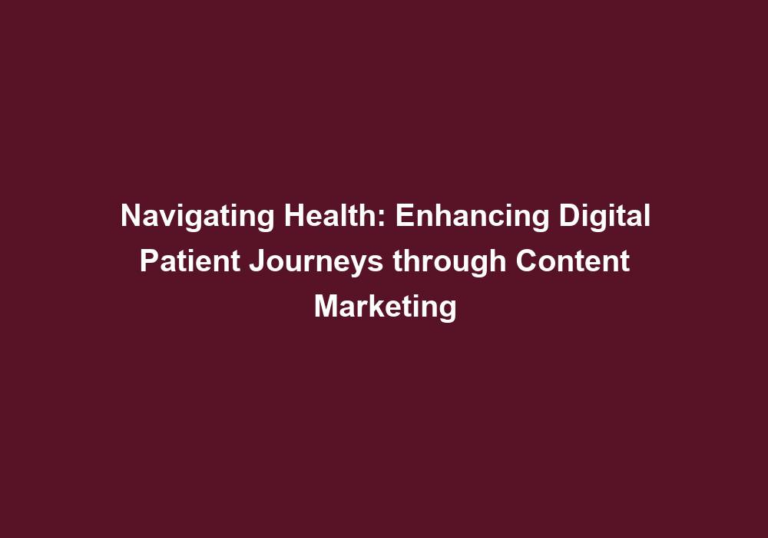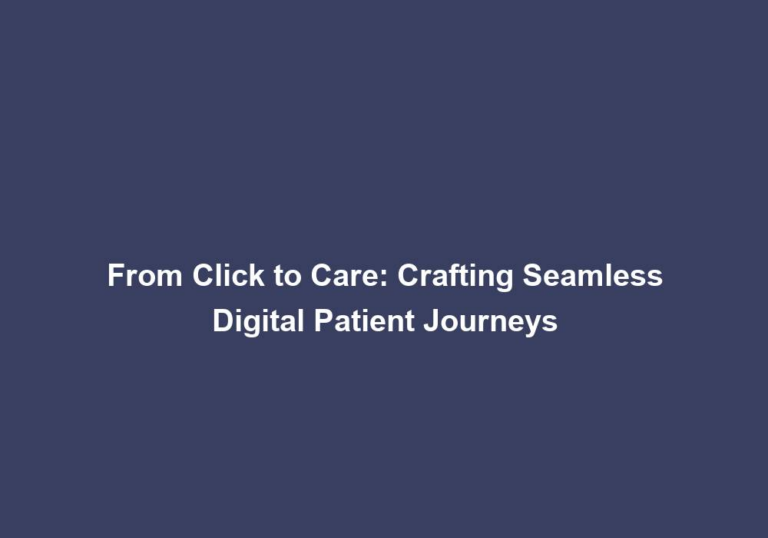Web Wellness: Enhancing the User Experience for Health Websites
In today’s digital age, having a strong online presence is crucial for businesses, especially for health-related websites. With the increasing number of people relying on the internet for health-related information, it is essential to provide a seamless and user-friendly experience to visitors. This is where the concept of Web Wellness comes into the picture.
What is Web Wellness?
Web Wellness is a term used to describe the practice of optimizing health websites to enhance the user experience. It involves various techniques and strategies aimed at ensuring that visitors can easily navigate through the website, find the information they need, and have a positive overall experience. By focusing on Web Wellness, health websites can not only attract more visitors but also build trust and credibility among their target audience.
The Importance of User Experience in Health Websites
- Building Trust: Health-related topics are often sensitive and personal, making it crucial for websites in this niche to build trust with their audience. A well-optimized website that provides a seamless and user-friendly experience can help establish credibility and trust among visitors.
A user-friendly website can create a sense of reliability and professionalism, which is essential when it comes to health-related topics. By ensuring that the website is easy to navigate, provides accurate and relevant information, and has a visually appealing design, health websites can instill confidence in their audience. Building trust is particularly important in the health industry, where users are looking for reliable sources of information and services.
- Increasing Engagement: A positive user experience encourages visitors to spend more time on a website, exploring different pages, and engaging with the content. This increased engagement can lead to better user retention and an increased likelihood of visitors returning to the website in the future.
Engagement is a key metric for the success of any website, including health websites. By providing an intuitive and enjoyable browsing experience, health websites can captivate their audience and keep them engaged. This can be achieved through various techniques such as interactive elements, personalized content recommendations, and easy-to-use navigation menus. Engaging content, such as articles, blog posts, and videos, can also play a significant role in keeping visitors on the website for longer periods.
- Improving Conversion Rates: When users have a pleasant experience on a health website, they are more likely to convert into leads or customers. By optimizing the user experience, health websites can improve their conversion rates and achieve their business goals.
Conversion rates are a critical factor for the success of any website, and health websites are no exception. By providing a seamless user experience, health websites can inspire confidence in their visitors and encourage them to take action. This can include signing up for a newsletter, making an appointment, or purchasing a product or service. By incorporating clear and compelling calls-to-action (CTAs) throughout the website, health websites can guide users towards the desired actions and increase their conversion rates.
- Enhancing Accessibility: Many individuals with health concerns may have specific accessibility needs. By focusing on Web Wellness, health websites can ensure that their content is accessible to all users, regardless of their abilities or disabilities.
Accessibility is a fundamental aspect of Web Wellness, as it ensures that all users can access and navigate the website without barriers. Health websites should comply with accessibility guidelines, such as those provided by the Web Content Accessibility Guidelines (WCAG), to accommodate individuals with disabilities. This may include providing alternative text for images, captions for videos, and keyboard navigation options. By prioritizing accessibility, health websites can cater to a wider audience and provide equal access to valuable health information and services.
Strategies for Enhancing Web Wellness
Now that we understand the importance of Web Wellness, let’s explore some effective strategies to enhance the user experience for health websites:
1. Intuitive Website Navigation
- Implement a clear and intuitive navigation menu that allows visitors to easily find the information they are looking for. A well-organized menu structure with logical categories and subcategories can make it easier for users to navigate through the website.
- Use logical categories and subcategories to organize content and ensure a seamless browsing experience. Grouping related information together can help users find what they need more efficiently.
- Include a search bar to facilitate quick and efficient searches within the website. This can be particularly useful for users who have a specific query or are looking for a particular piece of information.
2. Responsive Design
- Optimize the website for different devices, including desktops, tablets, and mobile phones. With the increasing use of smartphones and tablets, it is crucial to ensure that the website is accessible and provides a seamless experience across all devices.
- Ensure that the website layout and content adapt to different screen sizes, providing an optimal viewing experience for all users. Responsive design techniques, such as fluid grids and flexible images, can help achieve this.
- Prioritize mobile responsiveness, as an increasing number of users access the internet through their smartphones. This includes optimizing the website’s loading speed on mobile devices and ensuring that all interactive elements are easy to use on touch screens.
3. High-Quality and Engaging Content
- Create original, informative, and engaging content that addresses the needs and concerns of the target audience. Health websites should focus on providing accurate and reliable information that is backed by credible sources.
- Use a conversational tone and avoid jargon to make the content easily understandable for all visitors. Health-related information can often be complex, so it is essential to present it in a way that is accessible to users with varying levels of knowledge.
- Incorporate relevant visuals, such as images, videos, and infographics, to enhance the engagement and overall user experience. Visual content can help break up text-heavy pages and make the content more visually appealing and memorable.
4. Fast Loading Speed
- Optimize the website’s loading speed to minimize waiting times for visitors. Slow loading times can lead to user frustration and increase the likelihood of visitors leaving the website.
- Compress images and other media files to reduce their file sizes without compromising their quality. This can significantly improve loading times, especially for users with slower internet connections.
- Minimize the use of unnecessary plugins and scripts that could slow down the website. Regularly review and optimize the website’s code to ensure that it is clean and efficient.
5. Clear Call-to-Actions
- Include clear and compelling calls-to-action (CTAs) throughout the website to guide visitors towards desired actions. CTAs should be visually prominent and have persuasive language to encourage users to take the desired actions.
- Use visually appealing buttons and design elements to make the CTAs stand out and attract attention. The placement of CTAs should be strategic, ensuring that they are easily visible and accessible to users.
- Continually test and optimize CTAs to improve their effectiveness. A/B testing different variations of CTAs can help identify the most compelling and persuasive options.
6. Social Proof and Testimonials
- Highlight positive reviews, testimonials, and success stories from satisfied patients or customers. This can help build trust and credibility among visitors and provide social proof of the website’s reliability.
- Showcase certifications, awards, or accreditations to further establish trust and credibility. These credentials can demonstrate the expertise and professionalism of the website.
- Incorporate social proof elements, such as social media shares or follower counts, to demonstrate the popularity and trustworthiness of the website. This can create a sense of community and encourage visitors to engage with the website and its content.
7. Accessibility Considerations
- Ensure that the website meets the accessibility guidelines, such as those provided by the Web Content Accessibility Guidelines (WCAG). This includes providing alternative text for images, captions for videos, and clear navigation options for users with disabilities.
- Use alt tags for images, provide text transcripts for videos, and make sure that the website is navigable using only a keyboard. These considerations can make the website accessible to individuals with visual or motor impairments.
- Allow users to adjust the font size and color contrast to accommodate various visual impairments. Providing options for customization can enhance the user experience for individuals with specific accessibility needs.
By implementing these strategies and prioritizing Web Wellness, health websites can create a positive user experience that not only attracts visitors but also establishes trust and credibility. Remember, the ultimate goal is to provide valuable information, support, and guidance to users in their health journeys while ensuring a seamless and user-friendly experience throughout their interaction with the website.







